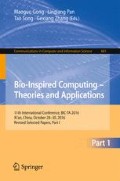Abstract
Spiking neural P systems are a class of distributed parallel computing devices inspired from the way neurons communicate by means of spikes. The necessary number of neurons to construct universal spiking neural P systems is a current research hotspot. In this work, we design the system by using the parallelism of the membrane system, and put all the instructions of the register machine in the same neuron. In this way, we can use less neurons to construct the system and make the simulation of instruction more concisely. With anti-spike, in instructions execution module, we only use standard rules. A universal systems without delay having 24 neurons is constructed.
Access this chapter
Tax calculation will be finalised at checkout
Purchases are for personal use only
References
Ionescu, M., Pǎun, G., Yokomori, T.: Spiking neural P systems. Fundam. Inform. 71, 279–308 (2006)
Pan, L.Q., Paun, G.: Spiking neural P systems: an improved normal form. Theor. Comput. Sci. 411, 906–918 (2010)
Păun, G.: Membrane Computing-An Introduction. Springer-Verlag, Berlin (2002)
Rozenberg, G., Salomaa, A.: Handbook of Formal Languages, 3 Volumes. Springer-Verlag, Berlin (1997)
Zhang, G.X., Cheng, J.X., Wang, T.: Membrane Computing: Theory and Applications. Science Press, Marrickville (2014)
Zhang, G.X., Pan, L.Q.: A survey of membrane computing as a new branch of natural computing. Chin. J. Comput. 33(2), 208–214 (2010)
Zhang, X.Y., Liu, Y.J., Luo, B., Pan, L.Q.: Computational power of tissue P systems for generating control languages. Inf. Sci. 278(10), 285–297 (2014)
Song, T., Gong, F., Liu, X.Y.: Spiking neural P systems with white hole neurons. IEEE Trans. Nanobiosci. (2016, in press). doi:10.1109/TNB.2016.2598879
Song, T., Pan, L.: Spiking neural P systems with request rules. Neurocomputing 193, 193–200 (2016)
Wang, X., Song, T., Gong, F.: On the computational power of spiking neural P systems with self-organization. Sci. Rep. 6, 27624 (2016)
Pǎun, A., Pǎun, G.: Small universal spiking neural P systems. BioSystems 90(1), 48–60 (2007)
Zhang, X.Y., Zeng, X.X., Pan, L.Q.: Smaller universal spiking neural P systems. Fundam. Inform. 87(1), 117–136 (2008)
Zhang, X.Y., Jiang, Y., Pan, L.Q.: Small universal spiking neural P systems with exhaustive use of rules. J. Comput. Theor. Nanosci. 7(5), 890–899 (2010)
Pan, L.Q., Zeng, X.X., Zhang, X.Y., et al.: Spiking neural P systems with weighted synapses. Neural Process. Lett. 35(1), 13–27 (2012)
Pan, L.Q., Zeng, X.X.: A Note on Small Universal Spiking Neural P Systems
Korec, I.: Small universal register machines. Theor. Comput. Sci. 168(2), 267–301 (1996)
Minsky, M.: Computation-Finite and Infinite Machines. Prentice Hall, Upper Saddle River (1967)
Pan, L.O., Pǎun, G.: Spiking neural P systems with anti-spikes. Int. J. Comput. Commun. Control 4(3), 273–282 (2009)
Krithivasan, K., Metta, V.P., Garg, D.: On string languages generated by spiking neural P systems with anti-spikes. Int. J. Found. Comput. Sci. 22(1), 15–27 (2011)
Peng, X.W., Fan, X.: Homogeneous spiking neural P systems with anti-spikes. J. Chin. Comput. Syst. (2013)
Song, T., Pan, L., Wang, J., Venkat, I.: Normal forms of spiking neural P systems with anti-spikes. IEEE Trans. Nanobiosci. 11(4), 273–282 (2012)
Song, T., Liu, X., Zeng, X.: Asynchronous spiking neural P systems with anti-spikes. Neural Process. Lett. 42(3), 1–15 (2014)
Song, T., Jiang, Y., Shi, X.: Small universal spiking neural P systems with anti-spikes. J. Comput. Theor. Nanosci. 10(4), 999–1006 (2013)
Zhang, X.Y., Pan, L.Q., Píĉun, A.: On universality of axon P systems. IEEE Trans. Neural Netw. Learn. Syst. 26(11), 2816–2829 (2015)
Zeng, X.X., Xu, L., Liu, X.R., Pan, L.Q.: On languages generated by spiking neural P systems with weights. Inf. Sci. 278, 423–433 (2014)
Wang, X., Song, T., Gong, F., Zheng, P.: On the computational power of spiking neural P systems with self-organization. Sci. Rep. (2016). doi:10.1038/srep27624
Zeng, X.X., Zhang, X.Y., Song, T., Pan, L.Q.: Spiking neural P systems with thresholds. Neural Comput. 26(7), 1340–1361 (2014)
Zhang, X.Y., Wang, B.J., Pan, L.Q.: Spiking neural P systems with a generalized use of rules. Neural Comput. 26(12), 2925–2943 (2014)
Zeng, X.X.: Research on computational property of spiking neural P systems. Hua Zhong University of Science Technology, Wuhan (2011)
Song, T.: Research on computational properties and applications of spiking neural P systems. Hua Zhong University of Science Technology, Wuhan (2013)
Acknowledgments
Zhou Kang is corresponding author. The work was supported by National Natural Science Foundation of China (Grant Nos. 61179032 and 61303116), the Special Scientific Research Fund of Food Public Welfare Profession of China (Grant No. 2015130043), the Research and Practice Project of Graduate Education Teaching Reform of Polytechnic University (YZ2015002), the Scientific research project of Wuhan Polytechnic University (2016Y01), the science and technology research project of the Hubei province (B201601).
Author information
Authors and Affiliations
Corresponding author
Editor information
Editors and Affiliations
Rights and permissions
Copyright information
© 2016 Springer Nature Singapore Pte Ltd.
About this paper
Cite this paper
Liu, S., Zhou, K., Zeng, S., Qi, H., Chen, X. (2016). An Improvement of Small Universal Spiking Neural P Systems with Anti-Spikes. In: Gong, M., Pan, L., Song, T., Zhang, G. (eds) Bio-inspired Computing – Theories and Applications. BIC-TA 2016. Communications in Computer and Information Science, vol 681. Springer, Singapore. https://doi.org/10.1007/978-981-10-3611-8_21
Download citation
DOI: https://doi.org/10.1007/978-981-10-3611-8_21
Published:
Publisher Name: Springer, Singapore
Print ISBN: 978-981-10-3610-1
Online ISBN: 978-981-10-3611-8
eBook Packages: Computer ScienceComputer Science (R0)

